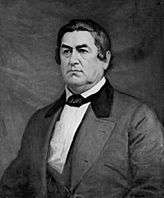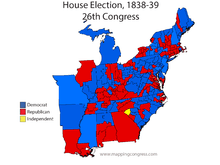United States House of Representatives elections, 1838
| | |||||||||||||||||||||||||||||||||||||||||||||||||||||||||||||||
| |||||||||||||||||||||||||||||||||||||||||||||||||||||||||||||||
| |||||||||||||||||||||||||||||||||||||||||||||||||||||||||||||||
| |||||||||||||||||||||||||||||||||||||||||||||||||||||||||||||||
Elections to the United States House of Representatives for the 26th Congress took place at various dates in each state, from July 2, 1838 (Louisiana) until November 5, 1839 (Mississippi), after the formal start of the 26th Congress but before the first session convened.
The Panic of 1837 set the background for this election cycle, as the carryover effects of the economic downturn led to Whig gains. President Martin Van Buren was deeply unpopular and Whig ideas for economic nationalism made slight inroads in suffering districts. However, the Democrats were able to lessen their loss by portraying the crisis as the result of missteps within the private banking industry and not as caused by government inactivity. The Anti-Masonic Party remained as a presence during this election, but also saw a drop in its seat total, while the Nullifier Party completely disappeared. Two Representatives in Virginia were elected under the Conservative Party label.
Election summaries
| 125 | 2 | 6 | 109 |
| Democratic | C | AM | Whig |
| State | Type | Date | Total seats |
Democratic | Whig | Others | |||
|---|---|---|---|---|---|---|---|---|---|
| Seats | Change | Seats | Change | Seats | Change | ||||
| Arkansas | At-large | October 1, 1838 | 1 | 1 | 0 | 0 | |||
| Delaware | At-large | November 13, 1838 | 1 | 1 | 0 | 0 | |||
| Georgia | At-large | October 1, 1838 | 9 | 0 | 9 | 0 | |||
| Illinois | District (3) | August 6, 1838 | 3 | 2 | 1 | 0 | |||
| Louisiana | District (3) | July 2–4, 1838 | 3 | 0 | 3 | 0 | |||
| Maine | District (8) | September 10, 1838 | 8 | 6 | 2 | 0 | |||
| Massachusetts | District (12) | November 12, 1838 | 12 | 2 | 10 | 0 | |||
| Michigan | At-large | November 6, 1838 | 1 | 1 | 0 | 0 | |||
| Missouri | At-large | August 6, 1838 | 2 | 2 | 0 | 0 | |||
| New Jersey | At-large | October 8, 1838 | 6 | 5 | 1 | 0 | |||
| New York | District (33[Note 1]) | November 5–7, 1838 | 40 | 19 | 21 | 0 | |||
| Ohio | District (19) | October 9, 1838 | 19 | 11 | 8 | 0 | |||
| Pennsylvania | District (25[Note 2]) | October 9, 1838 | 28 | 17 | 5 | 6[Note 3] | |||
| South Carolina | District (9) | October 8–9, 1838 | 9 | 8 | 1 | 0 | |||
| Vermont | District (5) | September 1, 1838 | 5 | 2 | 3 | 0 | |||
| 1839 elections | |||||||||
| Alabama | District (5) | August 5, 1839 | 5 | 3 | 2 | 0 | |||
| Connecticut | District (6) | April 1, 1839 | 6 | 0 | 6 | 0 | |||
| Indiana | District (7) | August 5, 1839 | 7 | 5 | 2 | 0 | |||
| Kentucky | District (13) | August 1, 1839 | 13 | 2 | 11 | 0 | |||
| Maryland | District (7[Note 5]) | October 3, 1839 | 8 | 5 | 3 | 0 | |||
| Mississippi | At-large | November 4–5, 1839 | 2 | 2 | 0 | 0 | |||
| New Hampshire | At-large | March 12, 1839 | 5 | 5 | 0 | 0 | |||
| North Carolina | District (13) | August 8, 1839 | 13 | 8 | 5 | 0 | |||
| Rhode Island | At-large | August 27, 1839 | 2 | 0 | 2 | 0 | |||
| Tennessee | District (13) | August 1, 1839 | 13 | 6 | 7 | 0 | |||
| Virginia | District (21) | May 23, 1839 | 21 | 12 | 7 | 2[Note 6] | |||
| Total | 242 | 125 51.7% |
|
109 45.0% |
|
8 3.3% |
| ||
Complete returns
Pennsylvania
| District | Incumbent | Party | First elected |
Result | Candidates[Note 7][1] |
|---|---|---|---|---|---|
| Pennsylvania 1 | Lemuel Paynter | Democratic | 1836 | Re-elected | Lemuel Paynter (D) 55.1% Joel B. Sutherland (W) 44.9% |
| Pennsylvania 2 Plural district with 2 seats |
John Sergeant | Whig | 1816 1836 |
Re-elected | George W. Toland (W) 69.4% John Sergeant (W) 69.2% Joseph R. Evans (D) 30.7% Samuel Brasnears (D) 30.7% |
| George W. Toland | Whig | 1836 | Re-elected | ||
| Pennsylvania 3 | Charles Naylor | Whig | 1837 (special) | Re-elected | Charles Naylor (W) 53.1% Charles J. Ingersoll (D) 46.9% |
| Pennsylvania 4 Plural district with 3 seats |
Edward Davies | Anti-Masonic | 1836 | Re-elected | John Edwards (AM) 57.2% Edward Davies (AM) 57.0% Francis James (AM) 57.0% Joshua Evans, Jr. (D) 43.0% Reah Frazer (D) 43.0% Samuel Leiper (D) 42.8% |
| Edward Darlington | Anti-Masonic | 1832 | Retired Anti-Masonic hold | ||
| David Potts, Jr. | Anti-Masonic | 1830 | Retired Anti-Masonic hold | ||
| Pennsylvania 5 | Jacob Fry, Jr. | Democratic | 1834 | Retired Democratic hold |
Joseph Fornance (D) 54.9% Joseph Royer (W) 45.1% |
| Pennsylvania 6 | Mathias Morris | Whig | 1834 | Lost re-election Democratic gain |
John Davis (D) 51.9% Mathias Morris (W) 48.1% |
| Pennsylvania 7 | David D. Wagener | Democratic | 1832 | Re-elected | David D. Wagener (D) 63.7% Peter S. Michler (W) 36.3% |
| Pennsylvania 8 | Edward B. Hubley | Democratic | 1834 | Retired Democratic hold |
Peter Newhard (D) 54.5% Walter C. Livingston (W) 45.5% |
| Pennsylvania 9 | George Keim | Democratic | 1838 (special) | Re-elected | George Keim (D) 69.3% Daniel M. Bieber (W) 30.7% |
| Pennsylvania 10 | Luther Reily | Democratic | 1836 | Retired Whig gain |
William Simonton (W) 59.1% William Reily (D) 40.9% |
| Pennsylvania 11 | Henry Logan | Democratic | 1834 | Retired Democratic hold |
James Gerry (D) 56.6% Charles A. Barnitz (W) 43.4% |
| Pennsylvania 12 | Daniel Sheffer | Democratic | 1836 | Lost re-election Whig gain |
James Cooper (W) 55.9% Daniel Sheffer (D) 44.1% |
| Pennsylvania 13 | Charles McClure | Democratic | 1836 | Retired Democratic hold |
William S. Ramsey (D) 57.3% Frederick Watts (W) 42.7% |
| Pennsylvania 14 | William W. Potter | Democratic | 1836 | Re-elected | William W. Potter (D) 50.9% William Irvin (W) 49.1% |
| Pennsylvania 15 | David Petrikin | Democratic | 1836 | Re-elected | David Petrikin (D) 53.5% David Hurley (W) 46.5% |
| Pennsylvania 16 | Robert H. Hammond | Democratic | 1836 | Re-elected | Robert H. Hammond (D) 56.6% James Morrill (W) 43.4% |
| Pennsylvania 17 | Samuel W. Morris | Democratic | 1836 | Re-elected | Samuel W. Morris (D) 54.2% William Willard (W) 45.8% |
| Pennsylvania 18 | Charles Ogle | Anti-Masonic | 1836 | Re-elected | Charles Ogle (AM) 55.9% Job Mann (D) 44.1% |
| Pennsylvania 19 | John Klingensmith, Jr. | Democratic | 1832 | Retired Democratic hold |
Albert G. Marchand (D) 60.9% Joseph Markle (W) 39.1% |
| Pennsylvania 20 | Andrew Buchanan | Democratic | 1832 | Retired Democratic hold |
Enos Hook (D) 62.4% Fideleo Hughes (W) 37.6% |
| Pennsylvania 21 | Thomas M. T. McKennan | Anti-Masonic | 1830 | Retired Democratic gain |
Isaac Leet (D) 50.1% Joseph Lawrence (W) 49.9% |
| Pennsylvania 22 | Richard Biddle | Anti-Masonic | 1836 | Re-elected | Richard Biddle (AM) 58.1% James Power (D) 41.9% |
| Pennsylvania 23 | William Beatty | Democratic | 1836 | Re-elected | William Beatty (D) 61.5% George W. Smith (W) 38.5% |
| Pennsylvania 24 | Thomas Henry | Anti-Masonic | 1836 | Re-elected | Thomas Henry (AM) 54.7% James D. White (D) 45.3% |
| Pennsylvania 25 | Arnold Plumer | Democratic | 1836 | Retired Democratic hold |
John Galbraith (D) 51.2% David Dick (W) 48.8% |
In the 3rd district, Charles Naylor's election was unsuccessfully contested by Charles J. Ingersoll.[2]
There were three special elections in Pennsylvania during the 26th Congress.[3] The first was in the 14th district to fill a vacancy left by the death of William W. Potter (D) on October 28, 1839, and was filled by George McCulloch (D). The second was in the 22nd district to fill a vacancy left by Richard Biddle's resignation and was filled by Henry M. Brackenridge (W). The third was held in the 13th district to fill a vacancy left by the death of William S. Ramsey (D) on October 17, 1840. Ramsey had also been re-elected to the 27th Congress and so an additional special election was held the following May to fill the vacancy in the 27th Congress.
See also
Notes
References
Bibliography
- Dubin, Michael J. (March 1, 1998). United States Congressional Elections, 1788-1997: The Official Results of the Elections of the 1st Through 105th Congresses. McFarland and Company. ISBN 978-0786402830.
- Martis, Kenneth C. (January 1, 1989). The Historical Atlas of Political Parties in the United States Congress, 1789-1989. Macmillan Publishing Company. ISBN 978-0029201701.
- Moore, John L., ed. (1994). Congressional Quarterly's Guide to U.S. Elections (Third ed.). Congressional Quarterly Inc. ISBN 978-0871879967.
- "Party Divisions of the House of Representatives* 1789–Present". Office of the Historian, House of United States House of Representatives. Retrieved January 21, 2015.
External links
- Office of the Historian (Office of Art & Archives, Office of the Clerk, U.S. House of Representatives)


